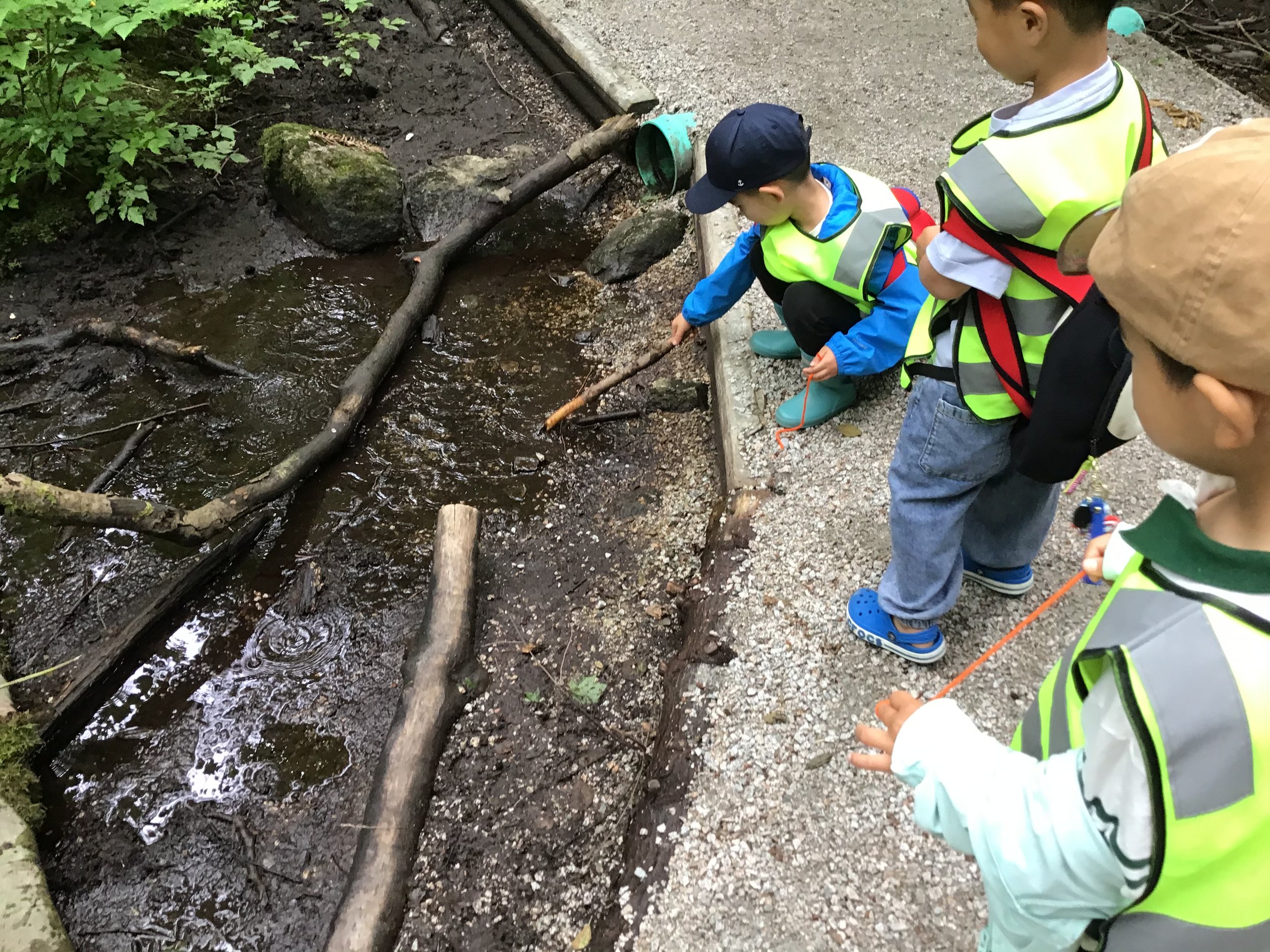Summer 2022
Level 3
This week we used books and field guides to learn about flora and fauna, and the environments in which we can find them. After our research, we shared our most fun facts with each other. We then went on a walk to observe the living things we could find in the water and on land and connected what we observed to what we read about. While we explored the living things around us, we learned about their different characteristics–especially the variety of sizes in our natural world. We used pieces of yarn to measure objects we saw to get a sense of the huge range. In order to prepare for a summer of outdoor camp, we also used this first day to get comfortable outside and familiarize ourselves with the outdoor elements we will continue to encounter. As the oldest students at camp, we assumed modelled leadership and responsibility to both the level 1 and level 2 students.
Expanding Our Senses
Pacific Spirit Park (UBC)
July 9
We learned about the curious creatures and the diverse plants that live in our forests, the many ways they move, the many places they hide, and how they’ve adapted for this specific environment. We studied the anatomy of insects and plants by studying the shapes and patterns they’re comprised of and considered how these elements have helped them survive in the biome we live in. Subsequently, we got creative and made our own insects by combing insect parts in our own unique ways. At the end of the day, we played games where we learned to wiggle and slither like bugs on the grounds and plants in the wind at a variety of speeds and rhythms. All the while, we encouraged and led the younger students.
Insect Environments
Musqueam Park
July 16
This week we explored the diversity of living things around us and identified as many as we could, including bees, ducks, lily pads, and trees. We learned about ecological associations by noticing certain plants and animals, like dragonflies and lily pads in ponds, tended to be grouped in the same habitats. We paid attention to the similarities and differences amongst the species in these habitats. After familiarizing ourselves with our native plants and animals, we were able to notice exotic elements that didn’t fit in, such as bamboo. We led discussion about why these plants were in a non-native environment and how they might have gotten there.
Aquatic/ Marine Biomes
Van Dusen Gardens
July 23
Today we put our engineering, technology, and design skills to the test by creating a minibeast paradise. We worked out the needs of the creatures we’d be housing and designed their homes to make them easily accessible. Also, we thought about potential dangers like predators and how we can protect against them. Later, we expanded our insect vocabulary while learning the types of insects, their life cycles, and their characteristics. Using a partial image of insects, we used our artistic skills to fill in the rest. Most importantly, we demonstrated respect and empathy for the tiny animals we interacted with by being careful not to disturb or harm them.
Characteristics of Small Creatures
Queen Elizabeth
July 30
Today we were detectives and searched for clues in our environment about which creatures had been there and what they had been doing there, like munched leaves and beetle bark. We considered where we would expect to find different creatures and why. We read a book all about water insects and then talked about what we learned with each other. We noticed and observed what was around us by drawing what we saw on the nature gallery table. We then did a messy math game with loose shapes and parts, and warmed our bodies up with a traffic light game and some insect-inspired dance moves!
Living Things Magnified
Camosun Bog
August 6
Today we thought about the ecological relationships around us. We focused on bigger creatures in the forest–birds, mammals, fungi, and more–and the symbiotic relationships between them, and between them and their environment. While we enjoyed our snack, we read a few books about plants and animals. We made sure to enjoy some meditative time journalling, observing, and completing a math activity to round off the day. Lastly, we paid attention to aquatic habitats in preparation for next week’s class.
Ocean Life Food Webs
Pacific Spirit Park (U-Hill Elementary)
August 13
Today at Jericho Pond we paid attention to birds, noticing their physical features, behaviours, habitat at Jericho Pond, abilities, and which species were around us. To start, we sang songs as a group and led in group discussion. In our discussion, we expressed curiosity and asked questions we hoped to be able to answer by the end of the day. We also answered the questions of other students if we knew the answers. We went on a nature walk which included a fun scavenger hunt, we practiced patterns with a math activity, and we had some unstructured play time. Throughout the day, we led by example to demonstrate our safety skills and independence during play time at the pond.
Can You Catch It?
Jericho Pond
August 20
What is a Watershed?
Vanier Park
August 27
Today we continued thinking about birds, especially seagulls! We looked for some facts about seagulls and other water birds in our non-fiction bird texts and field guides. When thinking about seagulls, we thought about how they can float on water, and wondered wat animals or objects also float vs. sink. In between talking about gulls, we practiced printing and tracing. We distinguished between symmetrical and as. We were also introduced to the concept of pollution and learned about its causes and effects. We did some journaling and learned a little bit about camouflage before wrapping up the final day of outdoor school!








